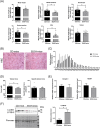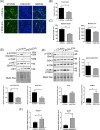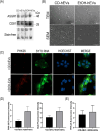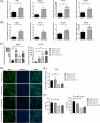Circulating Extracellular Vesicles in Alcoholic Liver Disease Affect Skeletal Muscle Homeostasis and Differentiation
- PMID: 39921321
- PMCID: PMC11806195
- DOI: 10.1002/jcsm.13675
Circulating Extracellular Vesicles in Alcoholic Liver Disease Affect Skeletal Muscle Homeostasis and Differentiation
Abstract
Background: The mechanisms underlying muscle alteration associated to alcoholic liver disease (ALD) are not fully understood and the physiopathologic mediators of the liver-muscle interplay remains elusive. We investigated the role of circulating extracellular vesicles (EVs) in ALD as potential mediators of muscle atrophy.
Methods: We established a mouse model of sarcopenia associated to ALD, by feeding mice with an alcoholic diet for 8 weeks. We investigated the effects of hepatic and circulating EVs isolated from these mice (EtOH mice; n = 7 females) on muscle cell cultures, comparing them with EVs from mice fed with a standard diet (CD mice; n = 6 females). Additionally, we examined the impact of circulating EVs from patients with alcohol-related cirrhosis (7 males and 2 females, mean age 55.4 years) on primary human muscle cells, comparing them with EVs from age-matched healthy subjects (6 males and 3 females). We analysed the miRNA profile of the EVs to identify potential mediators of ALD-associated sarcopenia.
Results: We demonstrated that circulating EVs were internalized by muscle cells and that EVs from ALD mice and cirrhotic patients caused alteration in the myogenic program. Molecular analysis revealed that serum EVs from ALD mice reduced protein synthesis in C2C12 cells, decreasing levels of p-AKT/AKT (-54.6%; p < 0.05), p-mTOR/mTOR (-54.5%; p < 0.05) and p-GSK3(Ser9)/GSK3 (-30.63%). Similarly, hepatic EVs induced defects in muscle differentiation, with reduced levels of p-AKT/AKT (-39.1%; p < 0.05), p-mTOR/mTOR (-30.1%; p < 0.05) and p-GSK3(Ser9)/GSK3 (-40%). C2C12 cells treated with either serum or hepatic EtOH-EVs exhibited upregulated expression of muscle-specific atrophy markers Atrogin-1 (+61.2% and +189.5%, respectively; p < 0.05) and MuRF1 (+260.4% and +112.5%, respectively; p < 0.05), along with an increased LC3-II/-I ratio (+131.5% and +40.2%, respectively; p < 0.05), indicating enhanced autophagy. MiRNA analysis revealed that both circulating and hepatic EVs from ALD mice showed elevated expression of miR-21, miR-155, miR-223 and miR-122 (+230% and +292%, respectively; p < 0.01) suggesting their potential role in sarcopenia. Human muscle cells exposed to EVs from cirrhotic patients exhibited reduced protein synthesis and upregulated Atrogin-1 (+113%; p < 0.05) and MuRF1 (+86.3%; p < 0.05), indicating proteasome activation. Circulating EVs of alcoholic patients showed upregulation of the same miRNAs observed in EtOH mice, including the liver-specific miR-122 (+260%; p < 0.05) suggesting, also in human liver disease, a hepatic origin of circulating EVs.
Conclusions: Our study highlights the critical role of ALD-derived circulating EVs in affecting muscle homeostasis and myogenic program, suggesting potential therapeutic targets for mitigating muscle loss in ALD.
Keywords: alcoholic liver disease (ALD); extracellular vesicles (EVs); liver‐muscle interplay; microRNA (miRNA); muscle atrophy; sarcopenia.
© 2024 The Author(s). Journal of Cachexia, Sarcopenia and Muscle published by Wiley Periodicals LLC.
Conflict of interest statement
The authors declare no conflicts of interest.
Figures








References
MeSH terms
Grants and funding
LinkOut - more resources
Full Text Sources
Miscellaneous

